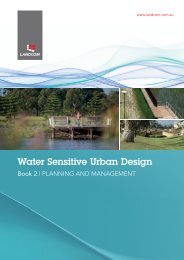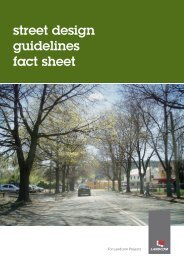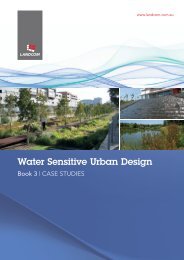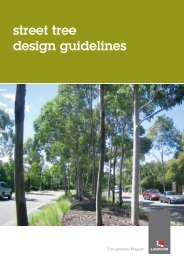Landcom Book 4 Maintenance - WSUD
Landcom Book 4 Maintenance - WSUD
Landcom Book 4 Maintenance - WSUD
You also want an ePaper? Increase the reach of your titles
YUMPU automatically turns print PDFs into web optimized ePapers that Google loves.
Water Sensitive Urban Design<br />
Detention pond | Garden Gates<br />
Open space | Victoria Park<br />
The location of the<br />
dewatering facility<br />
should consider<br />
existing site<br />
constraints.<br />
5.3.3 Liquid waste<br />
(from dewatering activities)<br />
Prior to discharge, the silt removed must<br />
be dewatered such that it does not<br />
contain any free liquid (that is, the density<br />
is 1.5 to 3 times the density of the material<br />
if completely dry (Collins, 2006)).<br />
The dewatering of collected silt can<br />
be accommodated in the design of<br />
the sedimentation basin, whereby free<br />
liquid is directed back into the treatment<br />
train. Alternatively, collected silt can be<br />
stockpiled within designated bunded<br />
areas offsite or stored in skip trucks<br />
brought into the site. The location of<br />
the dewatering facility should consider<br />
existing site constraints, DECC regulatory<br />
requirements, health and safety issues,<br />
odours and other community concerns<br />
(WBM and Ecological Engineering, 2005).<br />
Liquid removed during dewatering is likely<br />
to be classified as either Group A liquid<br />
waste or non-controlled aqueous liquid<br />
waste, depending on the concentration<br />
of suspended or dissolved chemicals<br />
(WBM and Ecological Engineering,<br />
2005). The level of contamination should<br />
be confirmed by laboratory testing;<br />
however it is likely that dewatered water<br />
will classified as non-controlled aqueous<br />
liquid waste.<br />
The decantered water must be treated<br />
prior to discharge to a receiving<br />
waterbody. Treatment can be achieved<br />
through many mechanisms, including:<br />
••<br />
Pumping decantered water to a settling<br />
tank to remove elevated levels of<br />
suspended solids. This may require the<br />
addition of a flocculent such as gypsum.<br />
••<br />
Decanting liquids to pervious areas,<br />
ensuring liquids are appropriately<br />
treated to meet reuse requirements.<br />
Potential implications of reusing<br />
decanted water from stormwater<br />
treatment measures include high<br />
pollutant (in particular heavy metal)<br />
concentrations and health risks posed<br />
by trapped pathogens.<br />
••<br />
Decanting liquids back into the<br />
stormwater treatment system.<br />
5.3.4 Equipment requirements<br />
For a sediment basin, wetland or pond,<br />
cleaning will generally require a backhoe,<br />
excavator or eductor / vacuum truck,<br />
requiring service from one to two vehicle<br />
operators and one to three labourers<br />
(HSC, 2001).<br />
The removal of waste from a bioretention<br />
basin must be done by hand to protect<br />
the bathymetry and compaction of the<br />
filter media.<br />
<strong>Book</strong> 4 | MAINTENANCE 37
















